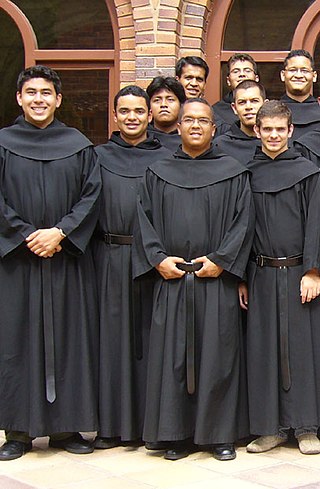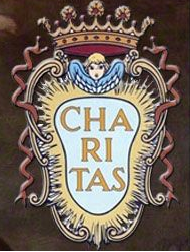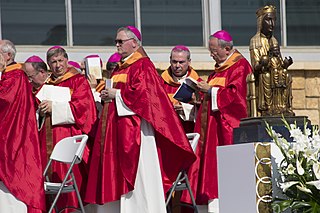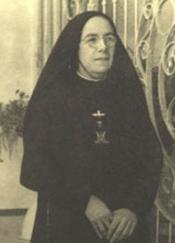
The Order of the Brothers of the Blessed Virgin Mary of Mount Carmel, known as the Carmelites or sometimes by synecdoche known simply as Carmel, is a mendicant order in the Catholic Church for both men and women. Historical records about its origin remain uncertain; it was probably founded in the 12th century on Mount Carmel in what is now Israel.

The Franciscans are a group of related mendicant religious orders of the Catholic Church. Founded in 1209 by the Italian saint Francis of Assisi, these orders include three independent orders for men, orders for nuns such as the Order of Saint Clare, and the Third Order of Saint Francis open to male and female members. They adhere to the teachings and spiritual disciplines of the founder and of his main associates and followers, such as Clare of Assisi, Anthony of Padua, and Elizabeth of Hungary. Several smaller Protestant Franciscan orders or other groups have been established since late 1800s as well, particularly in the Anglican and Lutheran traditions.

A friar is a member of one of the mendicant orders in the Roman Catholic Church. There are also friars outside of the Roman Catholic Church, such as within the Anglican Communion. The term, first used in the 12th or 13th century, distinguishes the mendicants' itinerant apostolic character, exercised broadly under the jurisdiction of a superior general, from the older monastic orders' allegiance to a single monastery formalized by their vow of stability. A friar may be in holy orders or be a non-ordained brother. The most significant orders of friars are the Dominicans, Franciscans, Augustinians, and Carmelites.

The Minims, officially known as the Order of Minims, and known in German-speaking countries as the Paulaner Order, are a Roman Catholic religious order of friars founded by Francis of Paola in fifteenth-century Italy. The order soon spread to France, Germany and Spain, and continues to exist today.

A scapular is a Western Christian garment suspended from the shoulders. There are two types of scapulars, the monastic and devotional scapular; both forms may simply be referred to as "scapular". As an object of popular piety, a scapular serves to remind wearers of their commitment to live a Christian life.

Mendicant orders are, primarily, certain Catholic religious orders that have vowed for their male members a lifestyle of poverty, traveling, and living in urban areas for purposes of preaching, evangelization, and ministry, especially to the poor. At their foundation these orders rejected the previously established monastic model, which prescribed living in one stable, isolated community where members worked at a trade and owned property in common, including land, buildings and other wealth. By contrast, the mendicants avoided owning property at all, did not work at a trade, and embraced a poor, often itinerant lifestyle. They depended for their survival on the goodwill of the people to whom they preached. The members of these orders are not called monks but friars.
The Society of the Atonement, also known as the Friars and Sisters of the Atonement or Graymoor Friars and Sisters, is a Franciscan religious congregation in the Catholic Church. The friars and sisters were founded in 1898 by Paul Wattson and Lurana White as a religious community in the Episcopal Church. The religious order is dedicated to the Blessed Virgin Mary under the Marian title of Our Lady of Atonement.

Mary of Jesus of Ágreda , OIC, also known as the Abbess of Ágreda, was a Franciscan abbess and spiritual writer, known especially for her extensive correspondence with King Philip IV of Spain and reports of her bilocation between Spain and its colonies in New Spain. She was a noted mystic of her era.
The Third Order of Saint Francis is a third order in the Franciscan tradition of Christianity, founded by the medieval Italian Catholic friar Francis of Assisi.

Joaquina Vedruna de Mas - born Joaquima de Vedruna Vidal de Mas, religious name Joaquina of Saint Francis of Assisi - was a Spanish religious sister and the founder of the Carmelite Sisters of Charity. Her canonisation was celebrated on 12 April 1959.

Candelaria of Saint Joseph was a Venezuelan religious sister and the founder of the Carmelite Sisters of Venezuela, also known as the "Carmelites of Mother Candelaria". The death of her parents in 1870 and 1887 prompted her to assume household responsibilities though in 1900 set her heart on aiding others in her area; this started in 1903 when she served as the director of a new hospital though she also tended to ill people during epidemics and conflicts that broke out over time.
When referring to Roman Catholic religious orders, the term second order refers to those communities of contemplative cloistered nuns which are a part of the religious orders that developed in the Middle Ages.
The following outline is provided as an overview of and topical guide to the Catholic Church:

The 522 Spanish Martyrs were victims of the Spanish Civil War beatified by the Roman Catholic Church on 13 October 2013 by order of Pope Francis. It was one of the largest number of persons ever beatified in a single ceremony in the Church's 2000-year history. They originated from all parts of Spain. Their ages ranged from 18 to 86 years old.

María Concepción of the Nativity and the Perpetual Help of Mary is the religious name of the Reverend Mother Foundress of The Order of Atonement of the Franciscan Minims of the Perpetual Help of Mary (mfPS) which she founded on June 24, 1942, in Zamora, Michoacan, Mexico.

Rafaela Porras Ayllón, religious name Mary of the Sacred Heart of Jesus, was a Spanish religious sister who established the Handmaids of the Sacred Heart of Jesus in conjunction with her sister Dolores. She devoted herself to the management of the congregation and resided in Rome until her death after her resignation as the congregation's superior in 1893.

Manuela de Jesús Arias Espinosa, also known by her religious name María Inés Teresa of the Blessed Sacrament, was a Mexican religious sister in the Roman Catholic Church and the founder of both the Poor Clare Missionaries of the Blessed Sacrament (1945) and the Missionaries of Christ for the Universal Church (1979). She lived during the time of the Cristero War and remained out of the nation during some of it in order to avoid the anti-religious persecution of the times.

Julia Navarrete Guerrero - in religious Julia of the Thorns of the Sacred Heart - was a Mexican Roman Catholic professed religious and the founder of the Misioneras Hijas de la Purísima Virgen María. Navarrete first felt called to promote religious education from her adolescence while still a student before moving to the national capital where she met the Jesuit priest Alberto Cuscó who formed her in the religious life. Not long after this she became a nun and set about founding schools and missions across both Mexico and the United States where she first started in Texas. Her brother Juan María Navarrete Guerrero became the Archbishop of Hermosillo and whose beatification process is ongoing.

Catholic religious institutions, associations, and communities in Macau operate in the territory of the Macau Special Administrative Region (MSAR), which is currently under the ecclesiastical jurisdiction of the Diocese of Macau, founded on 23 January 1576. Besides its diocesan priests, this Catholic diocese is assisted by various male and female religious orders, congregations, and institutes. The diocese is also supported by various institutions, movements, brotherhoods, and associations of Catholic inspiration made up of lay and religious people. All these Catholic bodies provide a variety of religious, social, educational, welfare, and cultural services to the Catholic and non-Catholic populations of Macau.















